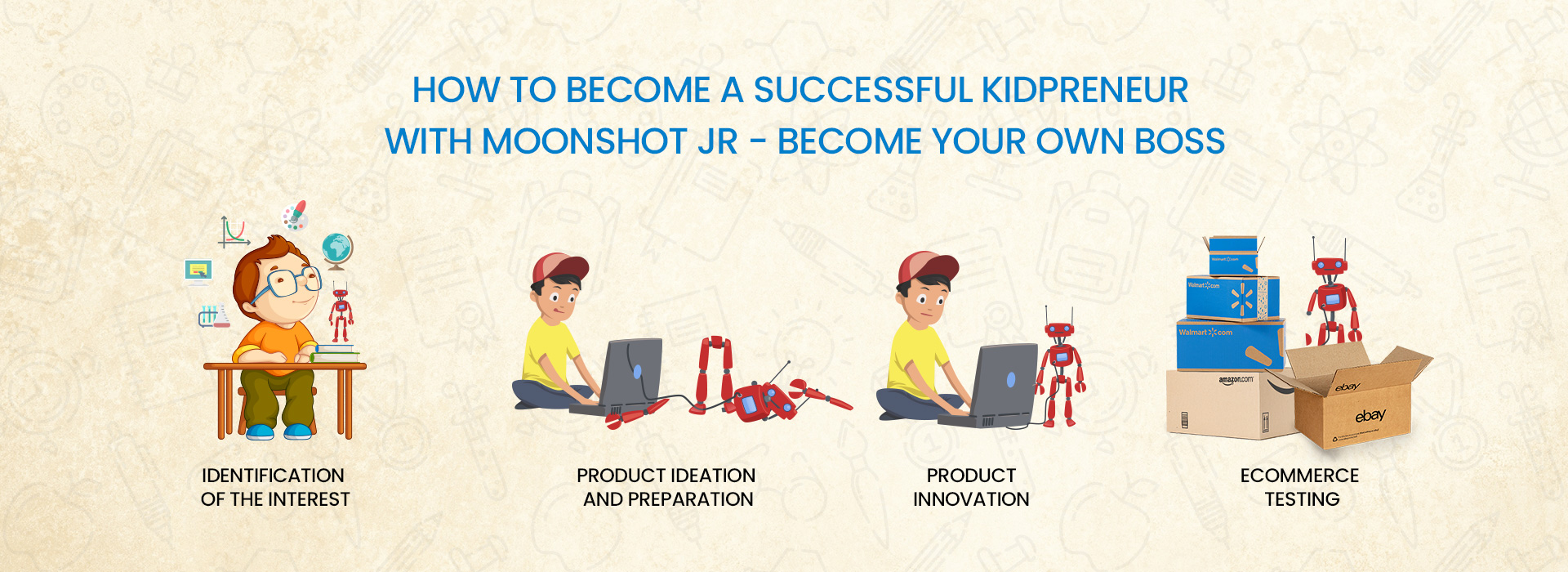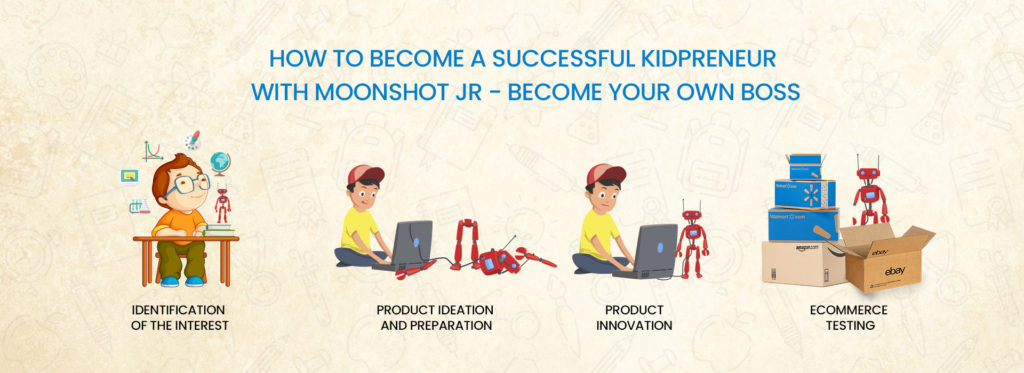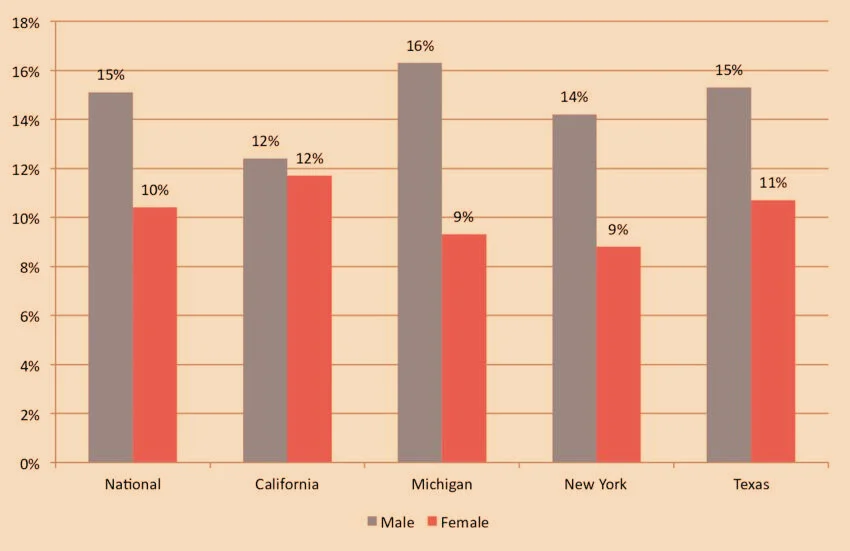

Update: This article was last updated on 16th April 2024 to reflect the accuracy and up-to-date information on the page.
Our children belong to the generation that is budding in a tech-loaded, interconnected environment. They have the technology to back their ideas and help them outperform their ancestors. But they need a platform to turn their ideas into a viable business.
This is where Moonpreneur steps in and lets young minds fiddle with technology & future ideas and channel them in the right direction. Moonpreneur guides children in adopting a four-step approach to getting them where they want to be: the business world.
Let’s see how Moonpreneur’s Innovator Program can help your child become a ‘kidpreneur’ and make them smart decision-makers.
Recommended Blog: HOW TO TEACH ENTREPRENEURSHIP TO YOUR KIDS USING MOONPRENEUR GAME
Step 1: Identification of the Interest
For any entrepreneur to become successful, it is essential to first choose a path. With children, it begins with mere interest that needs classification. Before coming up with something innovative, it is vital to make sure that you identify your child’s area of interest.
This is because one has to commit to an idea till the entrepreneurial idea is manifested, and the product is launched.
Innovation is seeing what everybody is seeing and thinking what nobody has thought.
– Albert Szent-Györgyi
At Moonpreneur, we expose your child to a variety of subjects in science, art, and technology. Children are encouraged to explore their hobbies and experiment with ideas that intrigue them.
Our committed and expert team tracks your child’s interests and provides ongoing support to explore them further. We also ensure that kids start pushing themselves beyond the textbook and engage in applying complex ideas. Once they grasp the basics of their interest, we see them as well on their way to becoming a kidpreneur.
Recommended Blog: 5 WAYS MOONPRENEUR WILL TEACH CHILDREN ABOUT ENTREPRENEURSHIP
Step 2: Product Ideation and Preparation

You must already know that just having an idea is not enough unless it is implemented and brought to fair use. Children have a lot of potential when it comes to ideation and given the guidance of the experts, they are channeled to think on the right path.
In the previous stage, the young minds explored more in-depth into the subject matter to understand the elements associated with the concepts of interest. At this stage, these elements are tested to perform practically.
Moonpreneur’s role at this stage is to provide the child with product-first learning, which introduces subjects and related concepts with a combination of entrepreneurial knowledge.
It is not from the benevolence of the butcher, the brewer, or the baker that we expect our dinner, but from their regard to their own self-interest. We address ourselves not to their humanity but to their self-love, and never talk to them of our own necessities, but of their advantages.
– Adam Smith
Moonpreneur helps students discover their hidden talents and focuses on fields with high productivity. Our students aim to lead future global businesses through profitable business ideas in AI, robotics, game development, app development, video creation, e-Commerce, etc.
Recommended Blog: EXPERT OPINION: WHY SCHOOL CURRICULUM SHOULD HAVE ENTREPRENEURSHIP EDUCATION
Step 3: Product Innovation

Children aspiring to be entrepreneurs must learn how to use and implement ideas for product innovation. This stage is crucial for entrepreneurship and includes applying everything they have learned to create a tangible product. Young minds often struggle to dedicate themselves to creating their product before starting their business, which is where the innovation experts at Moonpreneur help these kidpreneurs.
The 5-step innovation technique – empathize, define, ideate, prototype, and test – makes room for intensive learning, which is applied all along.
Empathizing and defining are the initial stages of identifying interests, followed by ideation, prototyping, and testing. Children are introduced to design thinking to turn their ideas into products/services.
Some of Moonpreneur’s students have developed innovative STEM toy ideas, which were deemed relevant due to the practical experiments associated with these toys.
Recommended Blog: HOW TO BECOME A SUCCESSFUL CHILD BLOGGER? START YOUR BLOG IN 2024
Step 4: E-Commerce Testing
A business succeeds when it meets the demand with its supply. Even great ideas need to be useful to customers to be relevant. The selling point hence becomes the prime testing point.
Moonpreneur helps children find an apt marketplace to promote ideas.
It is also essential that the product is well-funded, which becomes a problem as children are short of funds. The final step encapsulates the finance part as well. Students are introduced to crowdfunding platforms and how to raise funds.
Recommended Blog: 15 IMPORTANT LIFE SKILLS EVERY KID SHOULD LEARN BEFORE LEAVING HOME
At this stage, the kidpreneur develops a business model to propose the product, ensuring it meets expectations.
This dataset compares entrepreneurship across different age groups within the four states.
Summary
One common complaint among kids is not being taken seriously because most parents fail to realize that children are often more creative when they are young.
If your kid is brimming with ideas that you might not understand, Moonpreneur is here for them.
Moonpreneur is on a mission to disrupt traditional education and future-proof the next generation with holistic learning solutions. Its Innovator Program is building tomorrow’s workforce by training students in AI/ML, Robotics, Coding, IoT, and Apps, enabling entrepreneurship through experiential learning.


























What obstacles might Kidpreneurs run into, and how can they get beyond them?
Time management challenges, adult skepticism and financial setbacks are just a few of the challenges that Kidpreneurs face. These challenges can be overcome by asking for help, working through them and learning from them.
How can a kid-owned business grow?
Scaling tactics include reinvesting revenues, researching new product/service offers, and expanding gradually. Opportunities for advancement can also be found by networking and forming alliances.